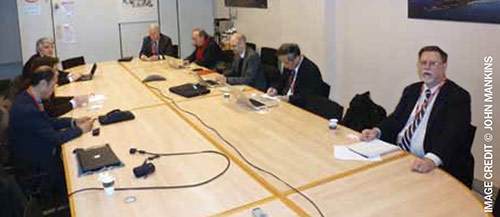On March 13, 2012 the Global Space Solar Power Working Group (Global SSP-WG) held its first meeting at the European Space Agency in Paris, France. All of the world’s major SSP players were represented, except for the Chinese. I had the honor of representing NSS.

The Global SSP-WG is organized under the auspices of the prestigious International Academy of Astronautics (IAA). It was created for the most part as a response to the very supportive IAA study of SSP (“Space Solar Power: the First International Assessment…”), which was published last fall. This report was the subject of NSS’ November 14, 2011 press conference, a video of which can be seen on our website at dcdev.nss.org/first-international-assessment-of-space-solar-power-press-conference-2011. A copy of the report can be found there as well.
The purpose of the Global SSP-WG is to facilitate communication and, where appropriate, cooperation between the players in the International SSP community. It will meet physically in conjunction with the IAA’s semi-annual conferences, the next of which will be held in Naples, Italy. John Mankins is the executive secretary of the organization. NSS expects to help with education and publicity efforts and possibly via our status as a non-governmental organization at the United Nations.
In November 2010, the IA A held the first Heads of Space Agencies Summit in Washington, D.C. The heads of 20 of the world’s space agencies were in attendance, including NASA Administrator Charles Bolden. The IAA plans to hold the second Heads of Space Agencies Summit in 2013. Current plans call for roughly a dozen topics to be discussed at this meeting. There is a good chance that SSP will be one of these topics, a possibility that the Global SSP-WG will encourage.
During the meeting, Susumu Sasaki from JAXA (loosely the Japanese equivalent of NASA) reported that the current phase of their SSP program is virtually complete and that the next phase of their program should produce a demonstration satellite four years from now.
Leopold Summerer, head of the European Space Agency’s Advanced Concepts Team, explained that they will probably produce a new SSP reference architecture soon. This will take into account the numerous relevant technical advances and insights that have occurred since the completion of the previous architecture.
I am saving comments about India’s SSP efforts and the ongoing Kalam-NSS SSP Initiative for a future issue of Ad Astra.
John Mankins discussed the progress in the relatively small NASA SSP program that he heads. This program began in fall of 2011. NSS plays a substantial role in the educational outreach part of the program. NSS’ 2012 International Space Development Conference will be used to provide a report to the public of the preliminary results of the first phase of the program.
The Chinese SSP program is largely secret. Apparently, they completed the first phase of their program last summer and are now engaged in a second phase at a substantially higher level of funding. It is plausible that at the time of the Paris meeting, the Chinese were spending more on SSP than the rest of the world combined.
The Chinese are famous for their long-range planning. Wang Xiji, a founder of the Chinese space program and leading Chinese space expert has said concerning SSP, “Whoever takes the lead in the development and utilization of clean and renewable energy and the space and aviation industry will be the world leader.”
This article was written by Mark Hopkins, Chairman of the Executive Committee of the National Space Society. The article originally appeared in Ad Astra, Summer, 2010.







